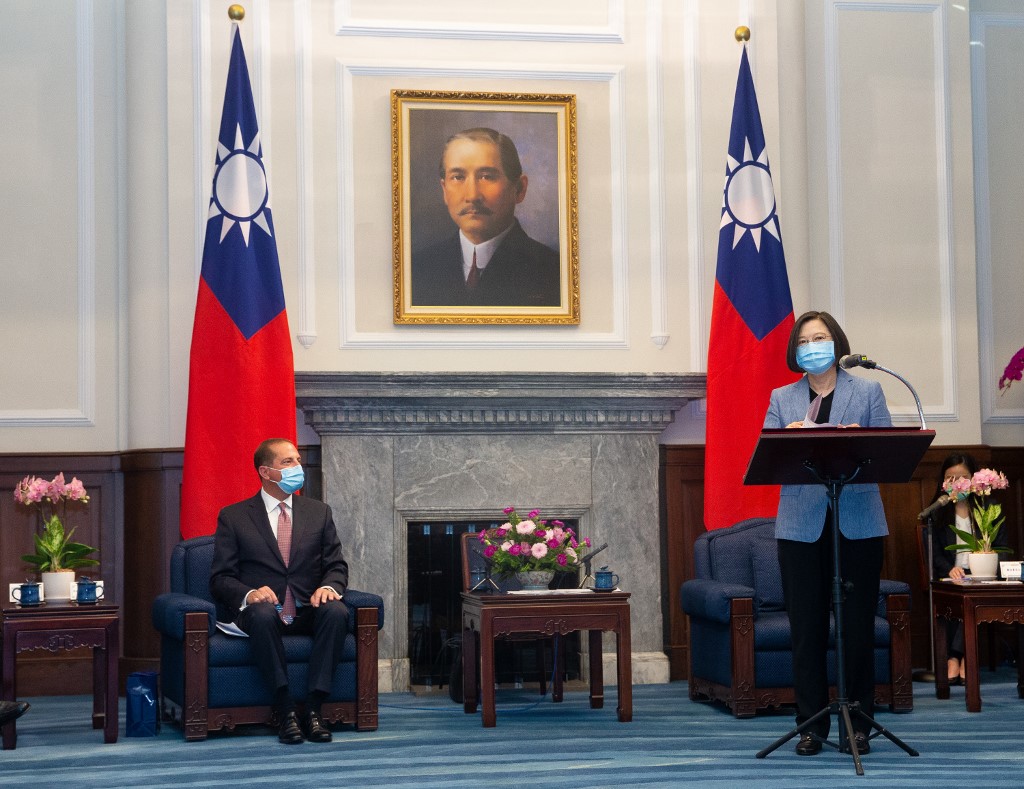David and Goliath: China and Taiwan’s military mismatch

US Secretary of Health and Human Services Alex Azar (L) looks on as Taiwan’s President Tsai Ing-wen (R) speaks during his visit to the Presidential Office in Taipei on August 10, 2020. – The US cabinet member met Taiwan’s leader on August 10 during the highest level visit from the United States since it switched diplomatic recognition from the island to China in 1979, a trip that Beijing has condemned. (Photo by Pei Chen / POOL / AFP)
TAIPEI, Taiwan — Few geopolitical contests are as mismatched as China and Taiwan.
One is an authoritarian regional superpower of 1.4 billion people that boasts the world’s largest standing army and spends more on its military than any other country except the United States.
The other is a self-ruled democracy of 23 million, a comparative economic and military minnow that lives under the threat of constant invasion.
The Taiwan Strait remains one of the world’s most dangerous flashpoints.
Tensions are on the rise again with the US sending its highest-level delegation to Taipei since Washington switched diplomatic recognition to China in 1979.
Article continues after this advertisementWhy are they enemies?
Taiwan and China split in 1949 when Chiang Kai-shek’s Nationalists fled to the island to set up a separate authoritarian government after losing a civil war on the mainland to Mao Zedong’s communists.
Article continues after this advertisementBoth sides claimed to represent China and for the first three decades, the conflict remained hot with China regularly shelling Taiwanese islands close to the mainland.
In the worst attack in 1958, the People’s Liberation Army fired 470,000 shells for 44 days, killing 618 servicemen and civilians.
As late as the 1970s, China was still bombarding the islands, although by then the shells were stuffed with propaganda leaflets.
A detente set in, followed by a tacit agreement in the early 1990s where both sides settled on there being “one China” but agreed to disagree on what that meant.
Since then, a more distinct Taiwanese identity has emerged that sees the island as a de facto independent state with a separate destiny from the Chinese mainland.
Where is Taiwan weak?
In sheer numbers and money, it is dwarfed by China’s military.
Taiwan has around 215,000 soldiers and a defence budget of $12 billion compared with China’s estimated two million armed forces backed by a budget of $178 billion.
China is a nuclear-armed state with a growing arsenal of state-of-the-art weaponry including advanced fighter jets, two aircraft carriers, and more on the way.
It also has a growing number of missiles, some of them hypersonic, positioned just across the Taiwan Strait and more than 60 submarines, including nuclear-powered vessels.
Taiwan’s 300 or so fighter jets have all been in services since the 1990s.
Its navy is massively outgunned by China’s — two of its four ageing submarines were built in the 1940s.
Where is Taiwan strong?
Military might is no guarantee of victory — insurgents have managed to bog down US-led NATO forces in Afghanistan for two decades.
Taiwan assesses that it does not need to match China dollar for dollar.
It has long planned for asymmetric warfare, safe in the knowledge that defending an island is far easier than taking it.
With many Western nations — until recently — reluctant to sell big-ticket military items lest they incur Beijing’s wrath, Taiwan developed a vibrant and innovative domestic weapons industry.
Comparatively cheap missiles, including some hypersonic variants, have become a big priority to make any Chinese invasion hugely costly.
What does China say?
Beijing continues to claim Taiwan and has vowed to one day seize it, by force if necessary.
Under President Xi Jinping, it has become more aggressive, especially after the 2016 election as president of Tsai Ing-wen, who rejects the idea of a “one China” and sees Taiwan as a de facto sovereign state.
Last year, Xi gave his most bellicose speech yet, warning that Taiwan’s reunification with the mainland is “inevitable”.
Military drills have been ramped up with Chinese fighter jets routinely flying into Taiwan’s defence zone.
Xi faces pressure from hardline nationalists who see Taiwan’s independence from the mainland as a slap in the face to the Chinese Communist Party.
Despite the pressure campaign, Taiwanese voters re-elected Tsai for a second term earlier this year in a landslide.
What is America’s role?
Washington is bound by Congress to provide Taiwan with arms to defend itself.
It recognises Beijing as China’s government but maintains a deliberately more opaque stance on Taiwan’s future status, saying any change must be achieved peacefully.
Since the mid-1990s, to placate China, US presidents were wary of selling major weaponry to the island, which frustrated Taipei.
That has changed under President Donald Trump, who has greenlit a number of major deals, including 66 next-generation F-16 fighters and an upgrade to the island’s Patriot missiles.
Taiwan is also one of the few issues that generate bipartisan support in the Trump era, with two recent bills upgrading diplomatic ties and exchanges.